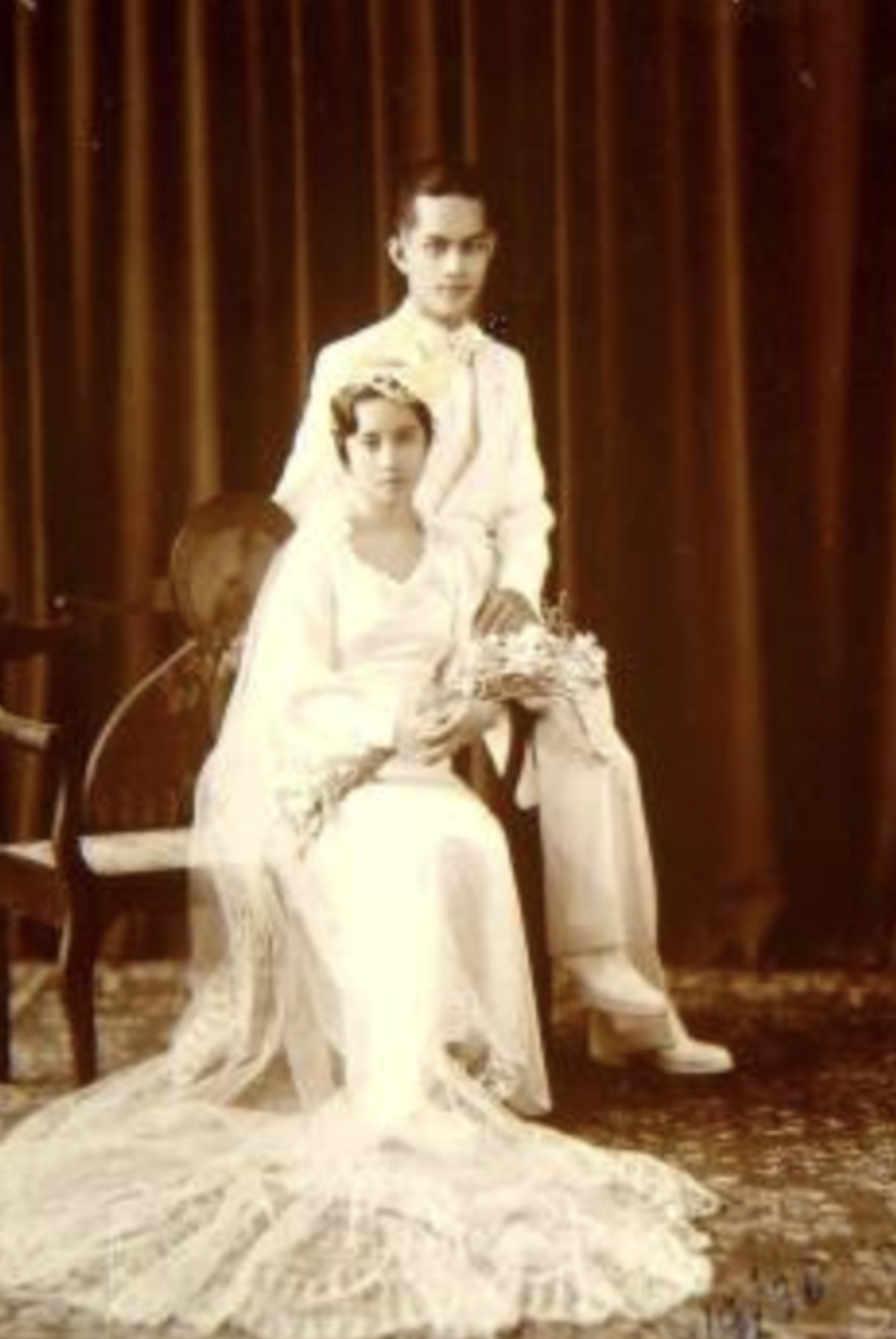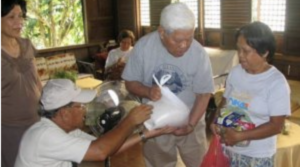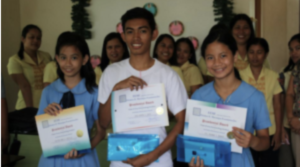Judge Eliodoro Evangelista Marasigan

(11/21/1915 – 8/2/1998)
Born in Inicbulan, Bauan, Batangas to parents Nicanor Castillo Marasigan and Petra Gonda Evangelista, Eliodoro married Rosario Esteban Marquez of Tondo, Manila and together they had ten children.
Professional Career
1933: Finished high school at Batangas High School
1935: Entered pre-law at the College of Liberal Arts, University of the Philippines and finished his law courses at the College of Law, University of the Philippines
1940: Passed the Bar Examination in 1940 with a grade of 81.6%
1940 – 1942: Private law practice
1942 – 1945: Guerilla Major, Blue Eagle Command (Underground guerilla leader against the Japanese during World War II)
March 1945 – June 1945: Member of 11th Airborne Division, US Army during liberation of the Philippines
June 1945 – November 1947: Chief Investigator, Base ‘R’, U.S. Army
1947: At this time, he earned the respect and support of the barrios of Inicbulan, Rizal and Durungao – that whoever he supported politically carried a big edge. His friend Feliciano Leviste was running for governor of Batangas and was challenged by an influential person Modesto Castillo, who was close to the Mayor of Bauan and Manuel Roxas, the President of the country. He was lured by the mayor to come to Manila to meet with secretary of Justice Ramon Ozaeta who told him that President Roxas would name him as Assistant Fiscal of Manila if he would support Castillo instead of Leviste. With due respect, he declined the offer because he already promised Leviste his support and to break his word was never an option to him. With his help, Leviste won the election.
1948: Governor Leviste made him Batangas Provincial Board Secretary. That same year he was offered, by his friend and then congressman, Pedro Munoz, whom he supported in previous election, to become the Fiscal of Batangas – a very prestigious government position – with one caveat; that to accept this position he had to sacrifice the P10,000 pork barrel appropriation for the Inicbulan school which will then be given to another barrio. He declined the position and opted for the P10,000 for the school. The money was used to build two classrooms. He did not stop there. He approached other politicians for funding to continue expanding the school and was able to get grants from President Garcia, Congressman Babao, Senator Jose P. Laurel, Claro Recto and Vice-President Fernando Lopez. The construction was supervised by his father Nicanor which added the H. E. and the shop buildings. Then he approached Speaker Jose B. Laurel, Jr. for more money to build the first high school building. He got that, also. In 1957, when the construction was finished, President Garcia granted him the greatest honor of accepting to come to Inicbulan to inaugurate the school building. It was the most glorious event that ever happened to the school.
1949 – 1954: Re-entered private law practice but continued to be politically active. In 1950, he and his father, Nicanor, successfully convinced governor Leviste to provide funds to build a potable water system by gravity from the mountain of Katmon in Guintuan, a few miles above Inicbulan. The project was completed and the water started to flow in adjacent barrios but the source did not have enough volume to reach the neighboring barrios of Rizal and Inicbulan. The father and son did not give up in getting water to Inicbulan and lobbied other politicians, including then President Ramon Magsaysay, to fund many artesian wells in both Inicbulan and Rizal. In 1952, he successfully acquired funds from then Speaker Eugenio Perez to build a large artesian well near the school. This well was a pet project of his father Nicanor. In 1979, his brother, Nemesio, applied his expertise in engineering and designed the first successful waterworks system in all of Bauan, by providing a huge pump, a storage tank at the highest peak in the barrio and a piping system with water meters. It now provides flowing water to every house in Inicbulan at the most affordable rate.
1954 – 1955: Manager, NASSCO (Appointed by President Magsaysay to the National Shipyard Corporation)
1956 – 1957: Examiner, Court of Agrarian Relations
1958 – 1968: Assistant City Fiscal, Manila (Appointed by President Garcia) In 1960, he and a group of prominent leaders in Rizal and Inicbulan formed an association called ‘Samahang Inibulan Rizal –S.I.R.’ whose main goal was to improve the lives of the peoples of the two barrios. In 1964, he showed courage in face of threats of his life by refusing security from the Manila Police department and continued his pursuit of justice against the most feared people in the government. In 1966, he was named ‘The Honest Public Servant of the Year’ by the Philippine Institute of Leadership.
1968 – 1973: Judge, Court of First Instance. He was nominated by Jose B Laurel, Jr. and was approved by his classmate and friend President Ferdinand Marcos. Marcos was his classmate in U.P. and they sat next to each other in classes – they being arranged alphabetically. He was visiting his children in the USA when Marcos declared martial law. He did not advocate what Marcos did so he resigned from office while in the states.
1973 – 1975: Columnist, Pilipino Reporter. He donated all his earnings to the teachers of Inicbulan High School who, at the time, were not being paid fairly by the government.
1975: Retired from work and relaxed by traveling with his wife and younger children in Europe and the Middle East. He also indulged himself with home gardening and caring for grandchildren.
A Love Story

(Tatay and Inay)
This is the love story of Inay and Tatay
A recollection by Eliodoro Marasigan, Jr.
Once upon a time, a handsome man from the mountains of Batangas met a beautiful maiden from Manila. They fell in love.
The rest was history.
The end? Not quite.
Pre-war days in the Philippines in the early 1930’s were unimaginable for many of us. The Philippines then was under the American rule and western influence was evident mostly in the urban areas like Manila. However, in the rural areas, progress was slow in coming. Many enterprising Filipinos in Manila took advantage of the opportunities opened for them and they got wealthy. Many others in the provinces stayed poor but some found a way to elevate themselves through education.
Inay’s family, (the Marquez’s of Tondo) was among the many successful families in Manila. They were rich. Her father, our Lolo Che (Jose Marquez) owned a lucrative business of supplying meat to different markets in Manila.
During those days, the Marquez’s family owned a big house in Tondo and an automobile. They were one of the first families in Manila to own a car with a personal driver to boot. All the Marquez’s children (Rosario-Inay, Natividad, Gaudencio, and Dominador) were enrolled in private schools. Inay was studying in St. Scholastica Colleges on her way to become a doctor.
(Gaudencio, or Ninong Guding, like Ninong Mesiong was a Bataan survivor. When the war broke in 1941, he was enrolled in the U.P taking up accounting. After the war, he worked with the PLDT, the telephone company, until he retired. He was able to come to the U.S. with Tiya Naty or Natividad, in the late 1970’s. He was the gentlest person I have ever known. ‘Sweet and gentle’ – as the song goes. He was a small man but his heart was big. When I was in my fourth year in high school, I was always short of money. Often I would go to Tondo and would ask Ninong Guding for a few pesos. One peso then could go a long way. One day, I needed money badly because I had a date with the most beautiful girl in class and I had only a few coins in my pocket. Unluckily, Ninong Guding did not have any money so he asked his wife Ninang Taleng how much she had. Five pesos, she said, and it was budgeted for groceries. I was down-hearted and was ready to leave empty handed when Ninong took the five pesos from Ninang Taleng and gave it to me. He said that my happiness is more important than his stomach. I refused to accept it but he shoved it in my pocket. With guilty conscience, I accepted. I owe him a gratitude I can never repay. My eyes get misty just to think of the love that he showed me. Dominador or Tiyo Doming was the playboy of the Marquez’s family, but that’s another story.)
The Marasigan family, during pre-war days, was far from being financially wealthy. However, the family was the most respected one in Inicbulan – a small barrio in the rural mountains of Batangas province. They were the elite of the barrio.
Tatay’s father, Lolo Canor (Nicanor Castillo Marasigan) was the leader of the community. He was the first educated person and first schoolteacher in Inicbulan. Before being a schoolteacher, he worked in a hardware store owned by the millionaire/philanthropist Teodoro R. Yangco. He and Lola Petra (Petra Evangelista Marasigan) instilled in the minds of their children the importance of education, honesty and integrity. Because of that, all their five children became professionals: Eliodoro, Sr. (Tatay) became a lawyer and CFI judge; Esteban, a medical doctor and medical director of a hospital in Zamboanga; Nemesio became the general manager of a pump manufacturing plant; Ismael, before he died, was a successful engineer; and Pilar became a teacher and, eventually, the principal of the school.
(Ismael, or Tiyo Mily, was Tatay’s youngest brother. He was a very young mechanical engineer in the early 1950’s. He had a very bright future ahead of him when he met a tragic accident on his scooter. Like Tiyo Bining, Tiyo Mily worked his way through college by driving the family jeepney for passenger fares. When he passed the board exam for engineers, a large manufacturing company in Makati hired him as a plant engineer. He quickly rose through the ranks and became the head of engineering. He was very close to my older sister, Ate Ludy, especially because he had a big crush on Ate Ludy’s friend and neighbor, Oying. Oying was a fairly attractive engineering student, a very good piano player, and an excellent dancer. She and Ate Ludy used to compete against each other during dance contests. Tiyo Mily was more than ten years our senior. He was not much of a dancer but that did not stop him from trying to learn the latest dance steps like the Boogie, Cha-cha and Tango. He wanted to keep in step with Oying. Ate Ludy and I taught him how to dance and he learned. It was at this period when he met the accident. He was on his way home from a store, where he bought a present for Oying, when a pedestrian suddenly dashed in front of him. He swerved and avoided hitting the pedestrian but in the process he crashed and hit his unprotected head on the pavement. He thought nothing of it because he was not physically hurt but, days later, he started to get severe headaches. He just took aspirins thinking it was only a migraine headache. He was wrong for it was more serious than that. Soon, he collapsed and died in the hospital of brain hemorrhage. He was in his young thirties. It was a terrible loss for the Marasigans.)
The Marasigan’s wealth was not measured in terms of pesos but in the richness of professional honors and individual prestige the family earned.
(Lolo Canor, was a politician by nature. In the early 1950’s, he ran, won, and was re-elected several times as town councilor in the town of Bauan by the widest margin in the town’s history. His intellect and gentle diplomacy easily earned him the respect of everyone. Between him and Tatay, they were able to solicit funds to build the school, bridges and roads of Inicbulan and the surrounding barrios. When he passed away, the one and only street in Inicbulan was named in his honor.
As a father and grandfather, he was a stern and principled authoritarian. But, in his heart, he was compassionate and caring person although he seldom showed it in public. In contrast, Lola Petra was warm and loving and she showed it openly.
I remember when we were teenagers; we spent every summer vacation in Inicbulan. Being young teens on vacation, we stayed out late or sometimes until early morning – every day of summer. Waking up early every morning was always a challenge for us. No problem for Lola. She would understandably let us stay in bed until we felt like getting up – and breakfast would be waiting for us on the table. Lolo Canor, on the other hand, would wake us up early, sleepy or not, to help him with the chores – like digging large deep holes in the ground for planting cacao trees. Or hauling horse manure to fertilize the cacao plants – the ones we would plant in the large holes we dug days before.
(During WWII, the family changed their religion from Roman Catholic to Protestant. Everyone in the family converted except Tatay who at the time had to be a Catholic because Inay was one. He later became a non-religious free thinker.)
Looking back, all of our grandparents from both sides of the family taught us some priceless lessons in life – the importance of love, compassion, leadership, honor and discipline. They showed us how it was done in their own ways. It was up to us to decide which traits and behaviors to emulate in our own lives.
Now we know that Tatay was from the mountains and Inay was from the city, so the question is – how did a poor striving man from the far-away barrio of Inicbulan meet a rich socialite lady from Manila?
Destiny or plain luck?
It was not luck that Tatay, after graduating from Batangas High School, was sent to Manila to become a lawyer. So, he enrolled in the University of the Philippines (UP) – the most prestigious school in Manila. Maybe it was luck that one of Tatay’s classmates happened to be Inay’s cousin.
So, in one Marquez’s family gathering, Inay’s cousin brought a class picture. In it, a very handsome face caught Inay’s eyes – that of Tatay’s. She developed a crush on Tatay. She was only 17 and Tatay was 19.
Inay’s cousin noticed the spark in Inay’s eyes while looking at Tatay’s picture, so he played the role of cupid and he did it beautifully. He successfully arranged the two to meet. It was love at first sight. Tatay recalled that Inay was the image of the beautiful Virgin Mary. Right then, he knew he had to win her and marry her.
Was it a perfect match?
Not really, it was not perfect at all. They had two strikes against them even before they exchanged hellos. Their parents wanted them to finish college and Lolo Ch’ was too protective that he prohibited her to talk to any man – Tatay included.
(Lolo Che was a gentle and loving person. He personified the ideal kindly grandfather every child would like to have. Inay’s mother, Lola Tonying (Antonia Esteban Marquez), was an ideal grandmother, too. She was even more affectionate and warmer than Lolo Che. I remember when Tatay moved us to Inicbulan, Lola Tonying would come visit us there. It probably took her days to make the trip. Yet, she never failed to come. She would bring us pasalubong – candies, toys, whatever she could afford to buy and carry. It has been a custom in the Marquez family to do this gesture of thoughtfulness as far as I can remember. Lola would spend most of her time with us grandchildren until it was time for her to go back to Manila. She only stopped doing this when the trip became too dangerous for travel and when her health started to fail.)
But, in spite of these obstacles, their love for each other started to bloom and, like other people in love, they found ways to get in touch. With the help of Inay’s cousin Gloria, they were able to exchange love notes and to meet secretly without getting caught. It was a brilliant conspiracy. They had sworn Gloria to secrecy and she became their special mail courier, chaperone and confidant.
Eventually, they were madly in love.
Inay was contented with the relationship but Tatay was impetuous. He was not satisfied with a few sneaky dates every now and then. His blood ran hot every time he was with Inay but could not do anything about it. So he proposed to marry her and she accepted.
That was the turning point in their lives. They were both very young, deeply in love, but without money or jobs. They sought the help of Lolo Mili.
Lolo Mili immediately arranged a meeting of the parents who at the time were not too eager to let them marry, Tatay’s mother (Lola Petra) most particularly. She had long dreamt of making Tatay the first person in Inicbulan to become a lawyer and he had a long way to go.
But, the meeting turned out amicably well. The parents were forgiving. They agreed to have the couple get married and to support them until Tatay graduated.
On May 9, 1936 they got married. Surely, it was destiny. The wedding was held in Tondo Catholic Church.
Inay was 18 and Tatay was 20.
To be continued.


